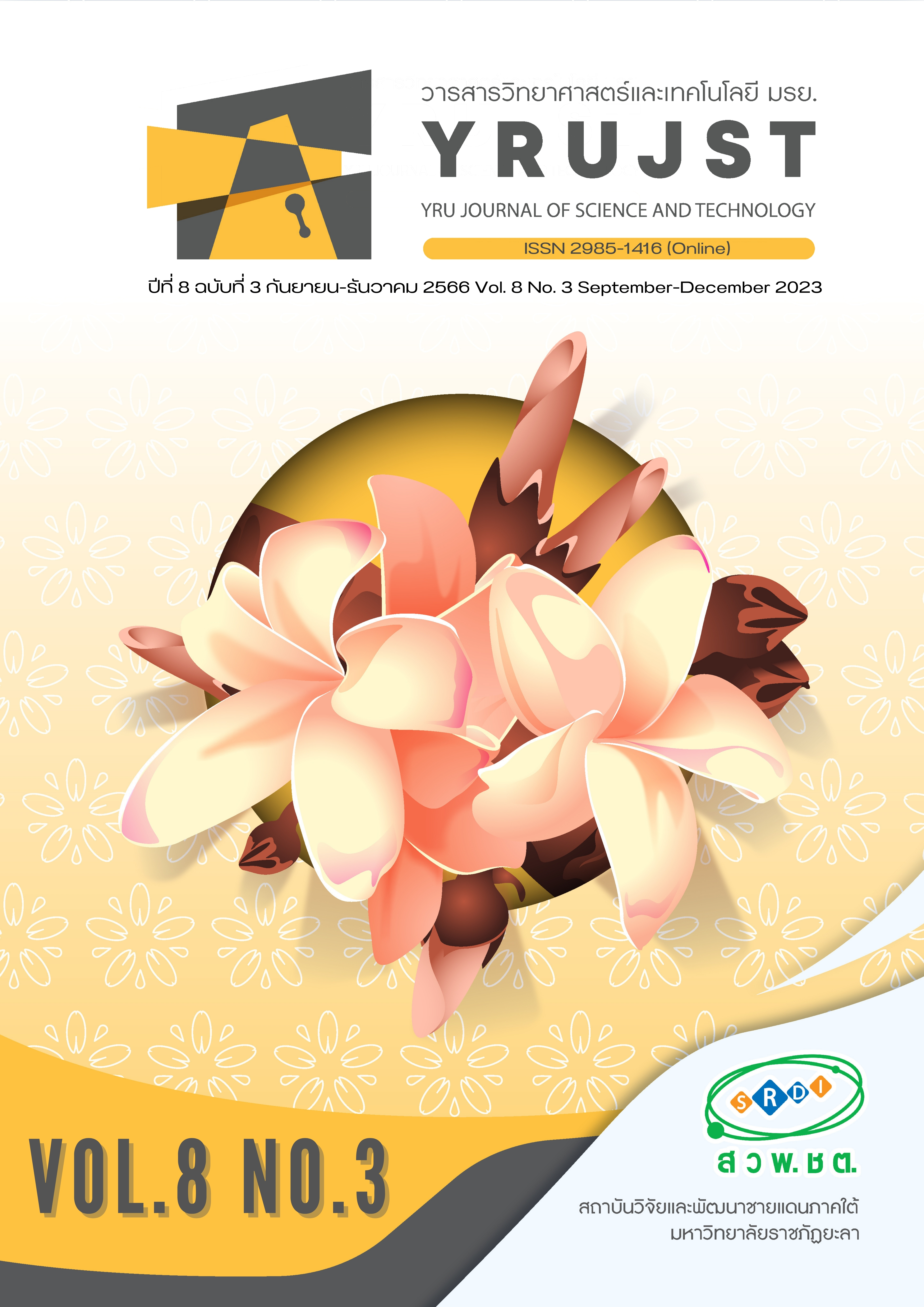การสกัดใบเปล้าหลวงและรางจืดด้วยเทคนิคไมโครเวฟเพื่อนำไปพัฒนาเป็นสูตรสารสกัดเข้มข้น สำหรับเป็นส่วนผสมในผลิตภัณฑ์สมุนไพร
Main Article Content
บทคัดย่อ
ปัจจุบันผลิตภัณฑ์เวชสำอางที่ผสมสารสกัดจากสมุนไพรกำลังได้รับความนิยมมากขึ้น แต่การสกัดสมุนไพรเข้มข้นที่เป็นส่วนผสมมักต้องใช้วิธีการที่ซับซ้อน มีต้นทุนสูง งานวิจัยนี้มีเป้าหมายเพื่อพัฒนาสูตรสารสกัดจากพืชสมุนไพร 2 ชนิด ได้แก่เปล้าหลวงและรางจืด โดยนำใบของเปล้าหลวงและรางจืดมาสกัดสารสำคัญด้วยเครื่องไมโครเวฟที่สภาวะของกำลังไฟและระยะเวลาแตกต่างกันพบว่า สภาวะที่เหมาะสมต่อการสกัดใบเปล้าหลวงคือการสกัดด้วยไมโครเวฟที่กำลังไฟ 100 วัตต์ เป็นเวลา 5 นาที จำนวน 1 รอบ ให้ค่าการได้คืนกลับเฉลี่ย 4.80 เปอร์เซ็นต์ ส่วนใบรางจืดคือการสกัดด้วยไมโครเวฟที่กำลังไฟ 300 วัตต์ เป็นเวลา 1 นาที จำนวน 5 รอบ ให้ค่าการได้คืนกลับเฉลี่ย 5.46 เปอร์เซ็นต์ เมื่อนำมาพัฒนาเป็นสูตรผสมสารสกัดในอัตราส่วนต่าง ๆ แล้ววิเคราะห์ฤทธิ์เบื้องต้นในการยับยั้งเชื้อแบคทีเรีย Staphylococcus aureus และปริมาณสารประกอบฟีนอลพบว่า สัดส่วนของสารสกัดสูตรที่ประกอบด้วยใบเปล้าหลวง : ใบรางจืด เท่ากับ 1 : 2 โดยน้ำหนัก มีความเหมาะสมต่อการนำไปพัฒนาเป็นสารสกัดเข้มข้นสำหรับนำไปผลิตเป็นสบู่ล้างหน้าและโลชั่นถนอมผิว เนื่องจากมีปริมาณสารประกอบฟีนอลทั้งหมดเท่ากับ 33.5 mg GAE/g DW และมีขนาดวงใสการยับยั้งเชื้อแบคทีเรีย S. aureus เท่ากับ 9.83 มิลลิเมตร เมื่อนำผลิตภัณฑ์ที่พัฒนาได้นั้นมาทดสอบความพึงพอใจของผู้บริโภคต่อผลิตภัณฑ์ ภายหลังการทดสอบใช้เป็นเวลา 1 สัปดาห์พบว่า ผลิตภัณฑ์เป็นที่ยอมรับของผู้บริโภค มีคะแนนอยู่ในระดับที่ชอบมากถึงชอบมากที่สุดทั้งสองผลิตภัณฑ์ งานวิจัยนี้ชี้ว่า การสกัดสมุนไพรด้วยไมโครเวฟเป็นวิธีการที่เหมาะกับชาวบ้านหรือกลุ่มวิสาหกิจชุมชนประยุกต์ใช้เพื่อการผลิตเป็นผลิตภัณฑ์สมุนไพร อย่างไรก็ตามควรมีการทดสอบคุณสมบัติของผลิตภัณฑ์ตามมาตรฐานที่เกี่ยวข้องต่อไป
Article Details

อนุญาตภายใต้เงื่อนไข Creative Commons Attribution-NonCommercial-NoDerivatives 4.0 International License.
บทความ ข้อมูล เนื้อหา รูปภาพ ฯลฯ ที่ได้รับการเผยแพร่ในวารสารวิทยาศาสตร์และเทคโนโลยี มรย. นี้ ถือเป็นลิขสิทธิ์ของวารสารวิทยาศาสตร์และเทคโนโลยี มรย. หากบุคคลหรือหน่วยงานใดต้องการนำทั้งหมดหรือส่วนหนึ่งส่วนใดไปเผยแพร่ต่อหรือกระทำการใดๆ จะต้องได้รับอนุญาตเป็นลายลักษณ์อักษรจากวารสารวิทยาศาสตร์และเทคโนโลยี มรย. ก่อนเท่านั้น
เอกสารอ้างอิง
Athikomkulchaia, S., Tadtonga, S., Ruangrungsib, N. & Hongratanaworakita, T. (2015). Chemical composition of the essential oil from Croton oblongifolius and its antibacterial activity against Propionibacterium acnes. Natural Product Communications, 10(8), 1459-1460.
Bagade, S. B. (2021). Recent advances in microwave assisted extraction of bioactive compounds from complex herbal samples: A Review. Critical Reviews in Analytical Chemistry, 51(2), 138-149.
Chan, E.W.C., Lye, P. Y., Eng, S. Y. & Tan, Y. P. (2013). Antioxidant properties of herbs with enhancement effects of drying treatments: a synopsis. Free Radicals and Antioxidants, 3(1), 2-6.
Dusi, S. & Saminathan, J. (2020). Formulation and evaluation of Aloe vera and Daucus carota herbal cream. International Journal of Pharmacy Research and Technology, 10(1), 31–36.
Hahnvajanawong, C. (2013). Natural products for prevention and treatment of cholangiocarcinoma. Srinagarind Medical Journal, 27, 371-380.
Herbal Medicine Database, Faculty of Pharmacy, Ubon Ratchathani University. (2021). Croton oblongifolius Roxb. [Online]. Retrieved November 27, 2021, from: http://www.phargarden.com/main.php?action=viewpage&pid=74. (in Thai)
Herbal Medicine Database, Faculty of Pharmacy, Ubon Ratchathani University. (2021). Thunbergia laurifolia Lindl. [Online]. Retrieved November 27, 2021, from: https://apps.phar.ubu.ac.th/phargarden/main.php?action=viewpage&pid=102. (in Thai)
Junsi, M. & Siripongvutikorn, S. (2016). Thunbergia laurifolia, a traditional herbal tea of Thailand: botanical, chemical composition, biological properties and processing influence. International Food Research Journal, 23(3), 923-927.
Maneewan, K. & Kornsarn, N. (2018). Microwave-assisted extraction of bioactive compounds from Piper betle Linn. leaves. Khon Kaen Agriculture Journal, 46, 1230-1235. (in Thai)
Malawet, T., Putkhaw, C., Chantabul, A., Kreaujan, S., Saitauwaen, T. & Aumpet, P. (2019). Products development of herbal soap from Peperomia pellucida. The 11th Walailak Research National Conference, March 27-28, 2019. Nakhon Si thammarat: Walailak University. (in Thai)
Nabbala, C. & Krasaekoopt, W. (2022). Microencapsulation of Thunbergia laurifolia crude extract and its antioxidant properties. Applied Science and Engineering Progress, 15(1), 1-12.
Pardede, C., Iriany, Tambun, R., Fitri, M.D. & Husna, R. (2020). Extraction of tannin from garlic skins by using microwave with ethanol as solvent. Materials Science and Engineering, 801, 1-7.
Ruangyuttikarna, W., Chattaviriya P. , Morkmeka, N., Chuncharuneeb, S. & Lertprasertsuke, N. (2013). Thunbergia laurifolia leaf extract mitigates cadmium toxicity in rats. ScienceAsia, 39, 19-25.
Ruksounjik, O. & Khunkitti, W. (2016). The comparative study in bioactivities of Rang jeud, Butterfly pea and red grape peel. Isan Journal of Pharmaceutical Sciences, 12(1), 61-69. (in Thai)
Siddiqui, N., Rauf, A., Latif, A. & Mahmood, Z. (2017). Spectrophotometric determination of the total phenolic content, spectral and fluorescence study of the herbal Unani drug Gul-e-Zoofa (Nepeta bracteata Benth). Journal of Taibah University Medical Sciences, 12(4), 360-363.
So-In, C. & Sunthamala, N. (2022). Treatment efficacy of Thunbergia laurifolia, Curcuma longa, Garcinia mangostana, and Andrographis paniculata extracts in Staphylococcus aureus-induced rabbit
dermatitis model. Veterinary World, 15(1), 188-197.
Suedee, A. (2017). Microwave-Assisted Extraction of Active Compounds from Medicinal Plants. EAU Heritage Journal Science and Technology, 11(1), 1-14. (in Thai)
Thitiwongsawet, P., Wongjanla, S. & Jandawong, W. (2016). Antibacterial soap containing the crude extracts of Phyllanthus emblica Linn. fruits. Srinakharinwirot University Journal of Science and Technology, 8(15), 27-39. (in Thai)
Wijesekera, K. (2017). A bioactive diterpene; Nasimalun A from Croton oblongifolius Roxb. Prayogik Rasayan, 1(2), 41-44.
Zhang, Y., Cai, P., Cheng, G. & Zhang, Y. (2022). A brief review of phenolic compounds identified from plants: their extraction, analysis, and biological activity. Natural Product Communications, 17(1), 1-14.


